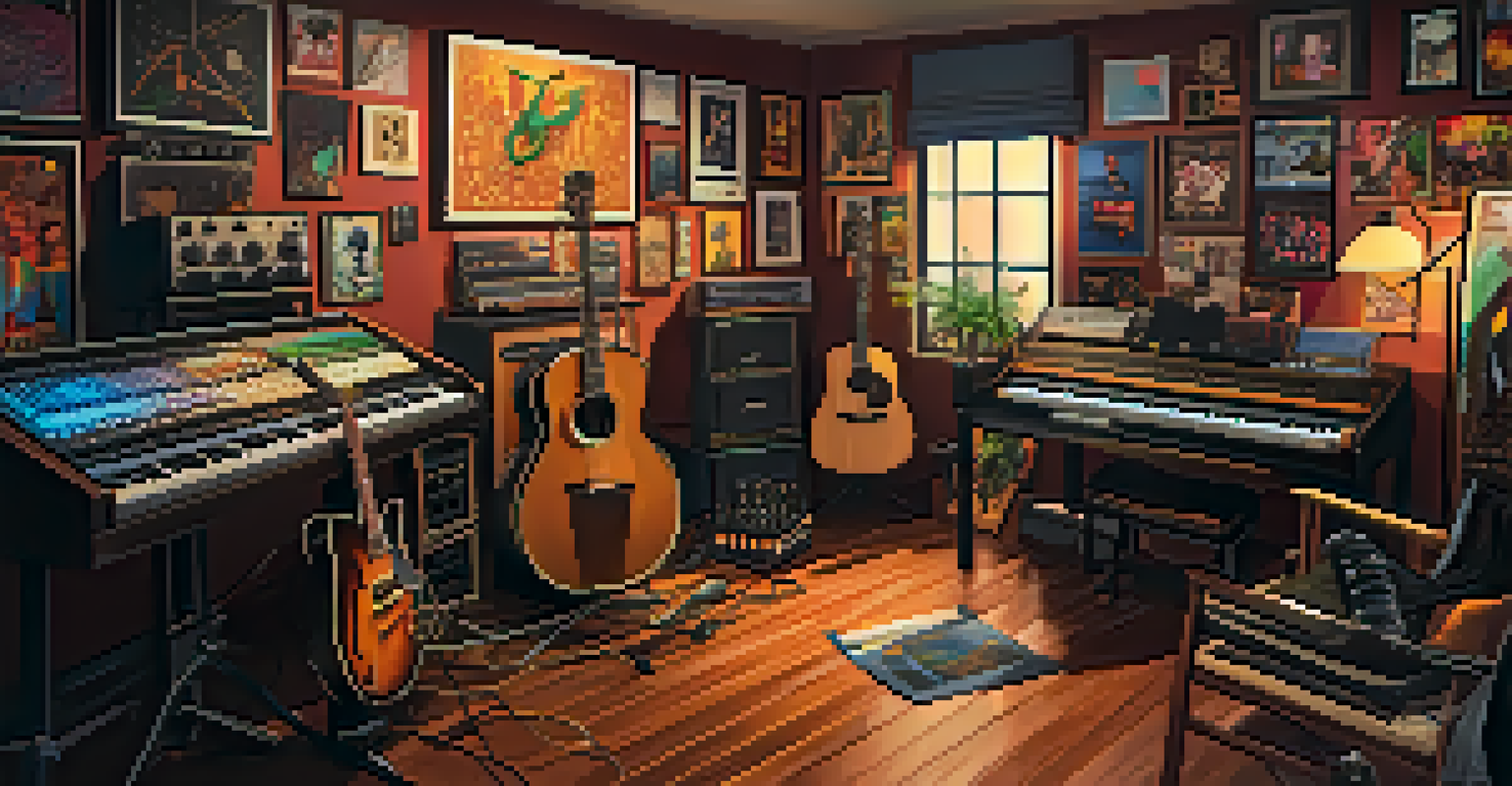From Folklore to Modern: Brazil's Evolving Music Scene

The Roots of Brazilian Music: A Rich Folklore Tradition
Brazil's music scene is deeply rooted in its diverse folklore, which dates back centuries. The melding of Indigenous, African, and European influences birthed unique genres that tell stories of the land and its people. For instance, the haunting sounds of the berimbau in capoeira echo the struggles and resilience of enslaved Africans in Brazil.
Music is the shorthand of emotion.
Folklore genres like forró and samba are not just musical styles; they represent the cultural identity of various regions in Brazil. Forró, with its accordion and zabumba, brings to life the rural landscapes of the Northeast, while samba encapsulates the vibrant spirit of Rio de Janeiro's Carnival. These genres create a tapestry of sound and story that connects generations.
As Brazil's music evolved, it began to embrace various influences, leading to the fusion of traditional sounds with modern elements. This evolution reflects the country's dynamic cultural landscape and showcases how music can be both a reflection of history and a canvas for innovation.
Samba: The Heartbeat of Brazilian Culture
Samba is arguably the most iconic genre associated with Brazil, symbolizing joy, community, and celebration. Originating in the Afro-Brazilian communities of Bahia, samba's infectious rhythms have become synonymous with Rio's Carnival. The vibrant parades, filled with dancers and elaborately designed floats, showcase the rich history and cultural pride of the Brazilian people.

The evolution of samba has seen it branch into various styles, including samba de roda and samba-enredo, each telling unique stories and capturing different emotions. This adaptability has allowed samba to remain relevant, fostering new generations of artists who experiment with its traditional roots. Artists like Martinho da Vila and Zeca Pagodinho have pushed the boundaries while honoring the genre's heritage.
Brazil's Music Blends Cultures
Brazilian music is a rich tapestry woven from Indigenous, African, and European influences, creating unique genres that reflect the country's diverse cultural identity.
Moreover, samba's influence extends beyond music; it has become a cultural phenomenon that fosters community bonds. Whether it's a backyard gathering or a grand festival, samba brings people together, creating a sense of belonging and joy that is quintessentially Brazilian.
Bossa Nova: The Cool Wave of Brazilian Music
In the late 1950s, a new wave of music emerged in Brazil known as bossa nova, characterized by its smooth melodies and laid-back rhythms. This genre, which literally means 'new trend,' combined elements of samba with jazz, creating a sophisticated sound that captivated audiences both in Brazil and abroad. Iconic songs like 'Garota de Ipanema' became timeless classics, showcasing the genre's lyrical beauty.
The only truth is music.
Bossa nova artists such as João Gilberto and Tom Jobim redefined Brazilian music, introducing a style that felt both intimate and expansive. Their innovative use of guitar, soft vocals, and intricate harmonies resonated with listeners, making bossa nova a symbol of the Brazilian cultural renaissance. This genre's emphasis on subtlety and mood marked a departure from the more exuberant samba.
As bossa nova gained international acclaim, it paved the way for other Brazilian genres to reach global audiences. Its influence can be heard in various music styles, demonstrating how Brazilian music continues to evolve while retaining its unique essence.
Tropicalia: A Cultural Revolution in Music
In the late 1960s, Brazil experienced a cultural explosion known as Tropicalia, a movement that blended music, art, and political activism. This avant-garde movement sought to incorporate diverse influences, such as rock, psychedelia, and traditional Brazilian sounds, creating a vibrant and provocative musical landscape. Artists like Caetano Veloso and Gilberto Gil became the faces of this movement, challenging societal norms through their music.
Tropicalia was not just about music; it was a response to the political climate of Brazil at the time, characterized by dictatorship and repression. The genre's experimental nature allowed artists to express their dissent while pushing the boundaries of creativity. Songs like 'Tropicália' became anthems of resistance and resilience.
Samba: A Cultural Phenomenon
Samba, originating from Afro-Brazilian communities, symbolizes joy and community, evolving over time while fostering a sense of belonging among Brazilians.
The legacy of Tropicalia continues to influence contemporary Brazilian music, encouraging artists to explore their identities and experiment with various sounds. This cultural revolution highlighted the importance of music as a vehicle for social change and self-expression, a theme that resonates in Brazil's music scene today.
Modern Brazilian Music: A Fusion of Genres
Today, Brazil's music scene is a vibrant tapestry of genres, reflecting the country's rich cultural diversity. From axé and sertanejo to funk carioca, modern Brazilian music continues to blend traditional elements with contemporary influences. This fusion creates a dynamic soundscape that resonates with both local and international audiences.
For instance, artists like Anitta and Seu Jorge exemplify this genre-blending approach, incorporating pop, hip-hop, and traditional rhythms into their music. Anitta's infectious hits have garnered global recognition, showcasing how Brazilian artists are breaking into the international music market. Similarly, Seu Jorge's soulful renditions of David Bowie songs in Portuguese highlight the global appeal of Brazilian music.
This evolution does not come without challenges, as artists navigate the balance between maintaining cultural authenticity and appealing to a global audience. However, the ongoing experimentation in modern Brazilian music serves as a testament to the country's innovative spirit and its ability to adapt while celebrating its roots.
The Role of Technology in Brazil's Music Evolution
Technology has played a pivotal role in shaping Brazil's modern music landscape, enabling artists to reach wider audiences than ever before. The rise of digital platforms like Spotify and YouTube has transformed how music is consumed, allowing emerging artists to showcase their talent without needing traditional record deals. This democratization of music has led to a flourishing of diverse voices in the industry.
Social media has also become a powerful tool for artists to connect with fans and promote their music. Platforms like Instagram and TikTok allow musicians to share snippets of their work, engage with audiences, and even create viral trends. This newfound accessibility has led to the discovery of fresh talent, making it easier for niche genres to gain traction.
Technology Shapes Music's Future
The rise of digital platforms and social media has democratized Brazil's music scene, allowing emerging artists to connect with global audiences and redefine traditional sounds.
While technology has opened doors, it has also introduced challenges, such as the need for artists to navigate an oversaturated market. Nonetheless, the interplay between technology and music continues to redefine how Brazil's rich musical heritage is experienced, ensuring that both traditional and modern influences coexist harmoniously.
The Global Impact of Brazilian Music Today
Brazilian music's global influence is undeniable, with genres like samba and bossa nova paving the way for international collaborations and cross-cultural exchanges. Artists from around the world are increasingly drawing inspiration from Brazil's rich musical heritage, showcasing the country's impact on the global stage. This globalization of Brazilian music has fostered a greater appreciation for its complexity and beauty.
Collaborations between Brazilian artists and international musicians have led to exciting new sounds. For example, the partnership between Brazilian singer-songwriter Adriana Calcanhotto and American musician Jack Johnson highlights how music transcends borders, creating a fusion that resonates with diverse audiences. Such collaborations not only elevate Brazilian music but also introduce it to new listeners.

As Brazilian music continues to evolve, its global footprint will only expand. The unique blend of traditional and contemporary influences reflects a vibrant culture that resonates with audiences worldwide, ensuring that Brazil's musical legacy remains a powerful force in the global music landscape.